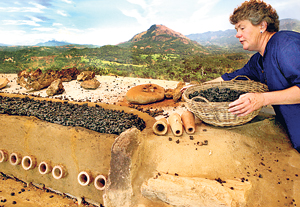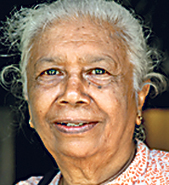Centuries ago, Arab writer Al Kindi referred to Sarandibi steel. Now comes the evidence that there had been in ancient Sri Lanka a large scale and highly successful metal producing industry which was based on a smelting and furnace design driven by the wind that only died out after the Chola invasion.
In the quiet of a museum room in Koggala, visitors are transported to a wind-swept hillside in Sabaragamuwa, circa 9th century AD, where flourished this ancient iron smelting industry. The unlikely link in uncovering the amazing skills of the Sabaragamuwa ironsmiths of yore and revealing their prowess, long buried, to the world is a British archaeologist from Exeter University Dr. Gill Juleff.
It was just last year that the link with the Martin Wickramasinghe Museum in Koggala was forged when a friend visiting Dr. Juleff’s site in Sabaragamuwa told her that her exploits were now the stuff of a comic book in Sri Lanka. Totally disbelieving until she was given a copy of ‘Steel Industry in Ancient Sri Lanka’ and found herself indeed the heroine of the story, a la Indiana Jones, Dr. Juleff lost no time in contacting the author Rupa Saparamadu.
 |
| Dr. Juleff puts the finishing touches to the exhibit. |
They met and then followed the invitation to Dr. Juleff to set up a model of the wind-powered furnace in the Koggala museum dedicated to the memory of Mrs Saparamadu’s father- literary giant Martin Wickramasinghe.
Down in Koggala last week, it was the culmination of a hectic three and a half weeks for Dr. Juleff and her team of students from Exeter University, putting the finishing touches to the full-scale model of the furnace which will now be on show at the Martin Wickramasinghe Museum revealing the story of Sri Lanka’s ancient ironsmiths.
How Dr. Juleff pieced this archaeological discovery together is too a tale worth relating.
Researching the environmental impacts of the Samanalaweva dam with archaeologist P.B. Karunaratne and the Archaeological Department team 20 years ago, her interest was aroused by the references to iron being smelted in Samanalaweva in Ananda Coomaraswamy’s 1908 book ‘Medieval Sinhalese Art’. “When I came there first, there was no one making iron. But there were people who remembered their grandfathers talking about it,” she recalls.
But their discovery of the bigger wind-powered furnaces, that produced iron on an industrial scale, was, in fact, an earlier chapter to the story, dating back to the mid 7th century AD and going on till the 11th Century. What they initially found in 1988 was to provide more questions than answers - numerous iron-smelting sites and large quantities of slag always on the western side of the summits of hills and ridges that took the brunt of the monsoon winds. Slag is the waste produced as result of iron smelting, a process that converts iron ore (rock) to iron metal. The slag was in long blocks rather than the rounded shapes that would be expected from a chimney-like furnace.
This intrigued Dr. Juleff: what were these furnaces like and how did they work? It was an arduous process to confirm their findings. The excavations carried out in 1990-91 to examine furnace remains in Galewalahinna revealed that the furnaces had been two-part structures made up of a permanent back wall in an elongated C shape made of clay and plastered into a shallow cut in the upper slope of the ridge. This wall was oriented north- south and had its open front facing westwards. The second part of the furnace was a front wall which connected the two corner stones and enclosed the structure. This was built on a line of tapering clay pipes called tuyeres that telescoped one into the other to form a barrier against which the molten slag accumulated inside the furnace. It was these that produced the elongated slag blocks.
In the wall built above the wall of tuyeres were other tuyeres inserted through the wall to allow air to be drawn into the front of the furnace. When the furnace was operating, some of the molten slag would seep through the small gaps in the base of the front wall and flow, lava-like down the slope in front of the furnace. When each smelt ended the front wall would be broken and the material inside collected while it was still red-hot and soft. The furnaces were often re-used Dr. Juleff found.
All the evidence pointed to a revolutionary technology that made use of the wind – the southwest monsoon winds that blow constantly from the west at speeds ranging from 20 to 80 km/h from June to September.
But when Dr. Juleff presented her findings to her colleagues back in the UK, she found herself up against another brick wall, literally. The only way to prove her theory was to recreate the furnaces and see if they actually worked the way they surmised.And so she returned in 1994 to actually build the furnace based on the archaeological data they had found. “In the middle of the second experiment, I had one of those Eureka moments when I understood exactly how the wind powered the furnaces,” she smiles.The results of the experiments were amazing: the individual fragments of slag from the experiments matched the archaeological examples and all of the experiments produced some metal, the most successful yielding 15-20 kg of metal.
The experimental smelts were the first time that iron had been smelted in a furnace driven exclusively by wind in modern times and Dr. Juleff’s findings were published in the international science journal Nature in 1994 in a cover story titled ‘New route to old iron’.
Further successful smelts were carried out in 2007.
The model of that ancient furnace built today at Koggala comes as close to the original as it can within the confines of a museum. “We brought down stones from Samanalaweva, even the charcoal, similar to that used in ancient times, made from the marang, pathberiya and damba wood,” says Dr. Juleff. The model is set against the backdrop of a panoramic photograph of the hills.
Detailed charts in English and soon in Sinhala too, explaining the history of the steel industry in ancient Sri Lanka and the Samanalaweva dig complete with photographs will provide visitors an accurate picture of a somewhat technical but fascinating story.
For the team of British archaeology students, this was a working holiday and in many ways, a revelation. “We naturally assumed that constructing the actual frame of the model would be the most difficult part. That was completed in two days because we had such a fantastic team of local craftsmen,” says first-year student Kay Hamilton. Adds Matt Saunders, full of admiration for their Sri Lankan associates- “It’s all to do with the skill of the hands while back home, it would be more about finding the right tools.”
An integral part of the team in Sri Lanka were retired archaeologist Alfred de Mel and Dr. Juleff’s helper from years past in Samanalaweva - Karunasena who first joined her as a schoolboy.
For Dr. Juleff the whole effort has been particularly gratifying—the result of many years of work now evident. If it all looks very cohesive now, it wasn’t for very long time, she admits. Happy to give something back to this country for which she has a deep affection and also much admiration--she is also keen that archaeological students, perhaps engineers too in Sri Lanka will be spurred to pursue their own investigations in search of other finds.
The live wire behind the museum
The Martin Wickramasinghe Museum of Folk Culture was established some twenty five years ago by the Martin Wickramasinghe Trust and today receives many visitors each day, often bus loads of school children. The live-wire behind it is Rupa Saparamadu, daughter of Martin Wickramasinghe who has been instrumental not just in its setting up, but in its continuing expansion.
 |
| Rupa Saparamadu |
The eldest daughter of the great man, she would often accompany her father on his travels and was hence privy to his discussions with archaeologist friends such as Dr. Senerath Paranavitane. Thus was sparked her own love of history, a subject she chose to study for her degree and subsequently taught.
Deeply dismayed by the government’s decision to scrap it from the school curriculum, her own effort to remedy the lack of knowledge of history among children, her own included, was to write books that would present facets of our country’s history in an easily understood form – comic books.
One of them was on the irrigation system of Sri Lanka followed by the one on ancient steel making, published both in Sinhala and English which led her to Dr. Juleff. |


